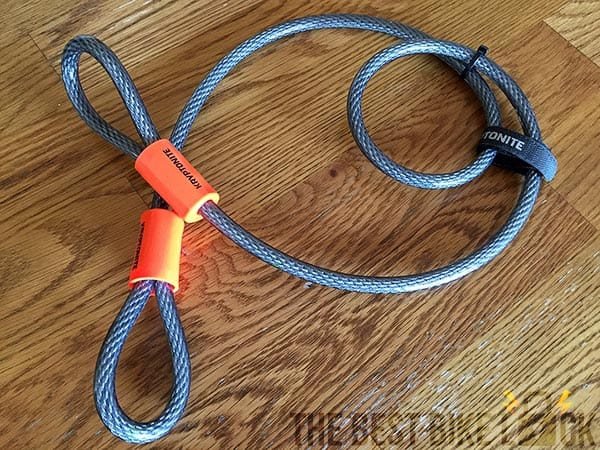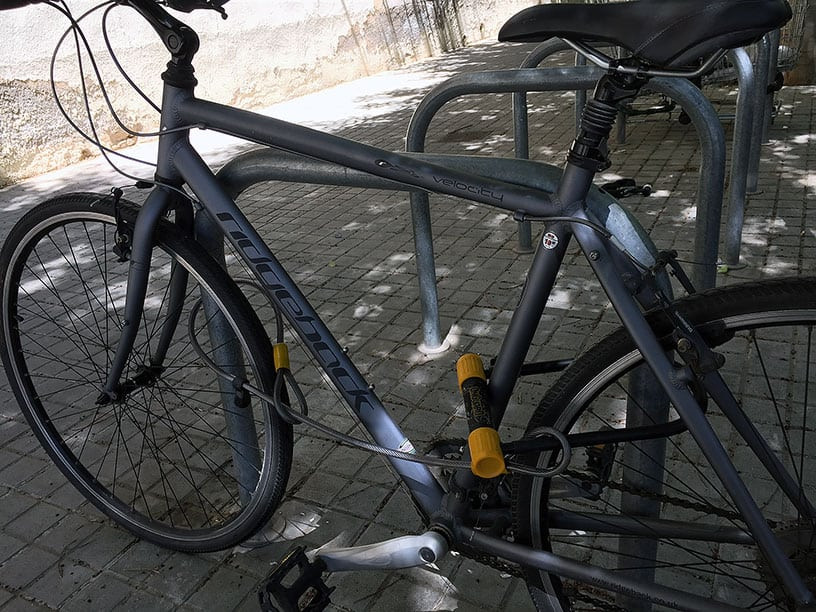Cable locks. They seem like such a convenient solution for bike security, right? Affordable, lightweight, easy to carry, and a breeze to wrap around your bike when you need to lock it up quickly.
However, there’s a harsh truth about bike cable locks that every cyclist needs to understand: they are simply not secure. In fact, relying on a cable lock as your primary bike security is practically inviting theft. It’s not a matter of if your bike will be stolen, but when.
So, if you’re considering buying a cable lock, please, make a promise to yourself right now: Never depend on a cable lock to protect your bike!
Perhaps you’re on this page because you’re thinking about getting a cable lock. Maybe you’re thinking, like many of us have at some point, “My bike isn’t that fancy, thieves probably won’t bother with it.” Or, “Shops sell these locks, so they must offer some reasonable security.”
That’s exactly what I thought before I bought a cable lock for my brand new bike. And guess what? The very first night I used it, my bike was gone. Stolen.
The reality is, no bike is “too crappy” to be stolen, and retailers selling cable locks aren’t really invested in whether your bike remains yours.
Still not convinced? Think I’m just trying to push you towards more expensive bike lock options? Let’s examine some real-world evidence, including videos and crime statistics.
Cable Locks vs. Thieves: A Losing Battle
To truly understand the weakness of cable locks, let’s watch some demonstrations of thieves in action. Keep in mind, any lock can be defeated given enough time and the right tools. But notice just how effortlessly thieves bypass cable locks.
Some cable locks are so inadequate that a thief can literally rip the bike free using brute force alone.
 Thief ripping cable lock
Thief ripping cable lock
A cable lock being easily defeated, emphasizing its vulnerability and lack of robust security.
Here’s another example where a thief uses a small pair of cable cutters – easily concealable and portable – to snip through the lock in seconds. Fortunately, in this instance, the thief was apprehended before they could take the bike.
 Thief cutting cable lock with small cutters
Thief cutting cable lock with small cutters
Demonstration of a cable lock being quickly cut with compact cable cutters, highlighting the speed and ease of defeating this type of lock.
Even thicker cable locks aren’t much better. They might require slightly larger cable cutters or bolt cutters, but the process remains quick and remarkably easy for a determined thief.
Crime Statistics Speak Volumes About Cable Locks
It’s not just anecdotal evidence; crime statistics back up the claim that cable locks are ineffective. Numerous studies and reports consistently show a strong correlation between cable lock usage and bike theft. Using a cable lock significantly increases the probability of your bike being stolen.
Harvard Police Department Data: Bike Thefts by Lock Type
Data from the Harvard Police Department in 2011 provides a stark illustration. Nearly two-thirds of bikes stolen on their campus were secured with cable locks. This data underscores the disproportionate risk associated with relying on cable locks for bike security.
Why Are Cable Locks So Vulnerable?
The inherent weakness of cable locks lies in their construction. They are typically made of multiple thin steel strands encased in a plastic tube. This design is what makes them lightweight, flexible, and cheap to manufacture, as it uses less steel.
However, these thin strands are precisely what make them so insecure. They are easily cut through with common tools like cable cutters or bolt cutters. These tools essentially slice through the thin cables one by one, much like scissors cutting through hair.
While thicker cable locks might appear more secure at first glance, the reality is often deceptive. The increased thickness primarily comes from a thicker plastic casing. The amount of steel inside, and thus the actual security, is not significantly improved.
Secondary Security: Can Cable Locks Play a Role?
The crucial takeaway is to never use a cable lock as your primary security. “Primary security” refers to the lock securing your bike frame to a fixed, immovable object – whether on the street or at home.
Many cyclists choose to use a secondary lock in addition to their primary lock. This can be another layer of security for the frame, or more commonly, to secure components like the front wheel or seat, especially if they have quick-release mechanisms.
Thin cable lassos are sometimes sold as secondary locks, often packaged with a primary U-lock. These lassos are designed to be used in conjunction with another lock, as they lack their own locking mechanism.
Personally, I’m not a fan of these cable lasso-style secondary locks. They can be snipped through rapidly with small, handheld cable cutters, offering minimal deterrence to thieves.
Furthermore, I find them cumbersome to use. They are often long and unwieldy, making them difficult to carry, maneuver around the bike when locking up, and untangle when you’re ready to ride.
 U-lock and cable lock securing bike wheel
U-lock and cable lock securing bike wheel
A U-lock used for primary frame security, supplemented by a cable lock securing the front wheel, illustrating a common but still vulnerable locking strategy.
Having said that, a cable lock is undeniably better than no lock at all for securing quick-release components. If your wheels or seat post use quick-release levers, you absolutely should protect them with something.
However, it’s essential to recognize that a cable lock provides only superficial protection. A determined thief targeting your wheel or seat will likely be able to steal them easily, even with a cable lock in place.
To be honest, there are far more secure and user-friendly ways to protect your wheels and seat. I strongly recommend exploring these alternatives before considering a cable lock for this purpose.
In Conclusion: Ditch the Cable Lock for Bike Security
The most crucial message regarding bike security is this: avoid using a cable lock as your primary means of securing your bicycle!
If cyclists collectively stopped using these ineffective locks, bike theft rates would likely decrease significantly.
It’s understandable why cable locks are appealing. They promise convenience – lightweight, easy to use and carry, and very affordable. But they utterly fail at their core function: protecting your bike from theft.
While you won’t find another lock type that perfectly replicates all the practical qualities of cable locks, you can find locks that offer some of those benefits while actually safeguarding your bike.
Consider what aspects of cable locks are most important to you and what compromises you’re willing to make in favor of genuine security.
Then, utilize my simple three-step guide to find a bike lock that balances ease of use with robust protection against theft!
Further Reading for Enhanced Bike Security:
- Best U-locks for Bike Security
- How to Lock Your Bike Properly: A Comprehensive Guide
